
TARZAN THE FEARLESS
Literally Speaking
by Alan Hanson
 “He knew no fear, as we know it; his little heart beat
the faster but from the excitement and exhilaration of adventure. Had the
opportunity presented itself he would have escaped, but solely because
his judgment told him he was no match for the great thing which confronted
him. And since reason showed him that successful flight was impossible
he met the gorilla squarely and bravely without a tremor of a single muscle,
or any sign of panic.” — Tarzan of the Apes
“He knew no fear, as we know it; his little heart beat
the faster but from the excitement and exhilaration of adventure. Had the
opportunity presented itself he would have escaped, but solely because
his judgment told him he was no match for the great thing which confronted
him. And since reason showed him that successful flight was impossible
he met the gorilla squarely and bravely without a tremor of a single muscle,
or any sign of panic.” — Tarzan of the Apes
Fearlessness — absolute and complete — was one of Tarzan
of the Ape’s most alluring traits, helping to make him one of fiction’s
most venerable heroes. Edgar Rice Burroughs recognized that civilization
had added a considerable measure of fear to the human condition, and that
one way to set aside one’s fears, at least temporarily, is to imagine one’s
self a courageous superman like Tarzan.
Tarzan was only 10 years old when Burroughs first affirmed
his fearlessness in the passage above. The incident also explained, at
least in part, the source of his courage — the environment in which he
was raised required it for survival. And, in fact, in Tarzan at the
Earth’s Core, the author declared that bravery was part of the
inheritance passed down to him from primitive man:
“… as it does not seem reasonable that a creature so
poorly equipped for offense and defense could have survived without courage,
it seems far more consistent to assume that with the dawning of reason
came a certain superiority complex — a vast and at first stupid egotism
— that knew caution, perhaps, but not fear; nor is any other theory tenable
unless we are to suppose that from the loin of a rabbit-hearted creature
sprang men who hunted the bison, the mammoth and the cave bear with crude
spears tipped with stone.”
Of course, according to Burroughs, civilization had long
since produced “numerous artificial protections” to be “thrown around
its brood of weaklings.” In Tarzan of the Apes, William
Clayton, Tarzan’s own cousin, modeled civilization’s cowardly brood. Cast
upon the primitive African shore, Clayton “fell into an agony of fear
and apprehension” when Jane Porter was in danger, and eventually nature
demanded the ultimate consequence for his lack of courage.
Tarzan’s father … “brave and fearless”
Fortunately for Tarzan, though, his father was not
among civilization’s “brood of weaklings.” Burroughs described
John Clayton, Lord Greystoke, as “brave and fearless, yet was he able
to appreciate the awful suffering which fear entails.” His courage
enabled him to survive and protect his family for 16 months in the wild
before a moment’s inattentiveness cost him his life. Inherent courage was
perhaps the most useful of the many qualities Tarzan inherited from his
father.
Of course, Tarzan’s upbringing among the great apes developed
in him an apparent absolute fearlessness that his father lacked. Not only
was the ape-man courageous, but also “he had but a vague conception” of
the nature of fear. Occasionally, Burroughs restated Tarzan’s ignorance
of fear in later stories. In Tarzan and the City of Gold,
the author noted that the ape-man “could not understand the meaning
of fear.” And when told that other men “trembled” in the presence
of Queen Nemone, Tarzan replied, “I have never trembled. How is it done?”
In Tarzan and “The Foreign Legion”, the ape-man was asked
if he had been afraid while battling a tiger. “Tarzan, who had never
been afraid in his life,” explained Burroughs, “was always at a
loss to answer this question, which had been put to him many times before.
He simply did not know what fear was.”
Tarzan not always fearless
Despite Burroughs’s claims that Tarzan was completely
without fear, there are a number of scattered references in the Tarzan
stories of him apparently feeling that emotion. The first was a fear of
water as a child. “He hated it because he connected it with the chill
and discomfort of the torrential rains,” Burroughs explained in Tarzan
of the Apes, “and he feared it for the thunder and lightning
and wind which accompanied them.”
Tarzan later admitted that fear was a general condition
of his childhood. When he first told his son Jack about his early life,
he described the “nakedness and fear and suffering” he had known
in the jungle. As a toddler, the ape-boy had been comforted by Kala when
he had been “frightened by Sabor, the lioness, or Histah, the snake.”
In Jungle Tales of Tarzan, Burroughs acknowledged
that, “nothing in the jungle inspired within the breast of Tarzan so
near a semblance to fear as did the hideous Histah … Never willingly had
he touched a snake.” It was not a real fear, Burroughs clarified, but
“an inherent repulsion bequeathed to him by many generations of civilized
ancestors.” Tarzan, though, used the word fear in reference to Histah
when urging his ape tribe to post lookouts for the great cats. “No others
need we fear, except Histah, the snake,” he explained.
Tarzan also admitted that as a child he feared members
of his own ape tribe. Coming upon a different tribe in Tarzan and
the Golden Lion conjured up a memory in which the ape-man saw again
the “great, savage brutes he had feared in youth and conquered in manhood.”
Nightmare brought knowledge of fear
Tarzan’s nightmare experience in Jungle Tales
of Tarzan suggests that the ape-boy had some conception of fear.
In his sleep, he found himself wishing to “flee his enemies as fled
Bara, the deer, most fearful of creatures. Thus, with a dream, came the
first faint tinge of a knowledge of fear, a knowledge which Tarzan, awake,
had never experienced.”
That he eventually grew to manhood in his savage environment
is evidence that Tarzan overcame the fears of his youth. He could not have
survived to maturity without doing so. In Tarzan Triumphant,
he acknowledged that his survival depended on the need “to establish
himself in the minds of all lesser creatures as one who walked without
fear and whom it was well to let alone.”
As an adult, Tarzan’s fears were never for his own welfare
but for the safety of others dear to him. Naturally, he feared most for
the wellbeing of his family. “It is not that I fear for myself,”
he told his friend Paul D’Arnot when he learned the villain Nicholas Rokoff
had escaped from prison in The Beasts of Tarzan. “Unless
I misjudge the man, he would more quickly strike at me through my wife
or son than directly at me, for he doubtless realizes that in no other
way could he inflict greater anguish upon me.” As he pursued her kidnappers,
the ape-man became “frantic” and after he rescued her, he feared
to leave her alone, even to hunt. And when he returned to his home to find
it destroyed in Tarzan the Untamed, it was with a “feeling
as nearly akin to terror as he ever had experienced” that he entered
the ruins fearing to find there his wife’s dead body.
Tarzan expressed fear for the welfare of several friends,
as well. In Tarzan, Lord of the Jungle, the ape-man feared
that Jad-bal-ja might have harmed the Princess Guinalda. “I was fearful
when I saw him beside you … for a lion is always a lion,” he told her.
And in Tarzan and the Lost Empire, he expressed concern for
his friend, Maximus Præclarus: “I have been fearful that by befriending
me you would bring disaster upon yourself.” The ape-man even feared
for the safety of his jungle friend, Tantor. In Jungle Tales,
“Tarzan tensed to the shock of a sudden fear” when he realized the
elephant was about to fall into a native pit.
Tarzan “shuddered” once
Burroughs recorded a few other instances of the ape-man
feeling fear. Tarzan claimed in Tarzan and the City of Gold that
he had never trembled, but in The Beasts of Tarzan, he did
something very much like it. While swimming across the Ugambi River, he
“shuddered” when he recalled how a crocodile had dragged him underwater
during a previous swim in the river. And while attempting to escape captivity
in Tarzan and the Ant Men, “he feared that any sudden
strains upon his series of hooks might straighten one of them and precipitate
him into the abyss below.” Later in the same story, when a fellow escapee
asked if a passing soldier had recognized him, Tarzan respond, “I fear
that he did.”
In Tarzan at the Earth’s Core, there are
three references to Tarzan being fearful. After being carried by a thipdar
to its lofty nest, Tarzan sought to escape by lowering himself over the
precipice with a rope. As he descended, “he held his breath for fear”
that he might topple to the jagged rocks below. The painful wounds caused
by the thipdar’s claws were sore, “but his only fear lay in the possibility
of blood poisoning.” Finally, after rejoining the crew of the 0-220
near the story’s end, “Tarzan was afraid to accompany [David Innes’s]
fleet back to Sari for fear that their rapidly diminishing store of fuel
would not be sufficient to complete the trip and carry them back to the
outer world.”
Such references to the ape-man’s fears are few and obscure
in the Tarzan series. In most of the cases, what Burroughs termed fears
could have been more accurately described as situations that caused Tarzan
some concern rather than actual fear. The reality is that in his Tarzan
stories Burroughs focused much more on the things that the ape-man did
not fear.
For example, although Tarzan’s primitive environment was
filled with deadly dangers, he faced it without doubt or fear, as would
a “lord in his own domain.” He feared not even the jungle night,
which brought terror to the hearts of even the bravest of civilized men.
Note how the jungle at night terrified the French officer Charpentier in
Apes:
“I never thought much about fear and that sort of thing
— never tried to determine whether I was a coward or a brave man; but the
other night as we lay in the jungle there after poor D’Arnot was taken,
and those jungle noises rose and fell around us I began to think that I
was a coward indeed. It was not the roaring and growling of the big beasts
that effected me so much as it was the stealthy noises — the ones that
you heard suddenly close by and then listened vainly for a repetition of
— the unaccountable sounds as of a great body moving almost noiselessly,
and the knowledge that you didn’t know how close it was, or whether it
were creeping closer after you ceased to hear it? It was those noises —
and the eyes.”
Respect for nature, but no fear of it
Although he didn’t fear the jungle, as a youth he
learned to accept his proper place in Nature’s hierarchy. “He knew no fear,”
Burroughs noted in Jungle Tales of Tarzan, “but in the
face of Nature’s manifestations of her cruel, immeasurable powers, he felt
very small — very small and very lonely.”
Because he did not fear nature, though, he was free from
the superstitions that held other humans captive in darkest Africa. Burroughs
explained in Tarzan the Magnificent:
“All too often had he been the object of the malign
necromancy of potent witch-doctors to fear their magic. Like the beasts
of the jungle, he was immune. For what reason he did not know. Perhaps
it was because he was without fear; perhaps his psychology was more that
of the beast than of man.”
Throughout his life, Tarzan fought numerous battles with
lions and panthers. He could not have survived all these encounters if
he feared Numa or Sheeta. In Pellucidar, “ … there came
strongly to his nostrils a scent that always caused the short hairs upon
his head to rise, not in fear but in natural reaction to the presence of
an hereditary enemy … it was the scent spoor of some sort of great cat.”
Death held no fear for the ape-man
On several occasions, Tarzan felt he was about to
die in battle with a lion, and yet he still felt no fear. In Tarzan
and the City of Gold, Tarzan’s lack of fear angered Queen Nemone
as she was about to have her hunting lion, Belthar, unleashed on him. Belthar
caused Tarzan no terror that day because he feared no lion, as well as
mankind’s ultimate enemy — death.
“There was no fear in him,” Burroughs declared
in The Return of Tarzan. “To a denizen of the cruel jungle,
death is a commonplace. The first law of nature compels them to cling tenaciously
to life — to fight for it; but it does not teach them to fear death.”
Since lethal danger was ever-present in Tarzan’s daily existence, fearing
death would have made his life unbearable. As he explained to his friend
Gemnon in Tarzan and the City of Gold, “I cannot let fear
rob me of my liberty and the pleasures of life; fear is to be more dreaded
than death … Were I afraid, I should be unhappy but no safer.”
Tarzan, then, faced each day’s events bravely as they
came, knowing that some day death would be one of those events. He possessed
what he called, “the fatalism of the jungle.” In Tarzan and
the Lion Man, he explained: “Perhaps I feel that what is about
to happen is about to happen and that being afraid won’t help any.”
And asked if he feared dying in Tarzan and the Leopard Men,
he responded, “I know the word, but what has it to do with death? All
things die. Were you to tell me that I must live forever, then I might
feel fear.”
Of course, his fatalism about the inevitability of death
did not mean he would meekly surrender to it. Death was a possible outcome
on each day of his life, but he took action each day to put it off until
at least tomorrow. In addition to shunning fear, he never worried. “He
merely awaited the next event in his life,” Burroughs noted in Tarzan
the Magnificent, “composed in the knowledge that whatever it
was he would meet it with natural resources beyond those of ordinary men.”
Self-preservation and caution
Although he didn’t fear death, Tarzan had a strong
primal instinct of self-preservation. Nature’s first law “activated
more or less unconsciously” in the ape-man, and that, combined with
reason and intelligence, allowed him to face dangerous situations with
confidence. The struggle for life in the wild taught him to let caution,
not fear, guide his actions.
“Regardless of the fact that Tarzan felt no such fear
of the lion as you and I might experience under like circumstances,”
Burroughs explained in Tarzan the Untamed, “He yet was
imbued with the sense of caution that is necessary to all creatures of
the wild if they are to survive.” In Tarzan the Terrible,
the author added, “ … he was wise enough to know when discretion was
the better part of valor and now, as in the past, he yielded to that law
which dominates the kindred of the wild, preventing them from courting
danger uselessly, whose lives are sufficiently filled with danger in their
ordinary routine of feeding and mating.” Where Tarzan was concerned,
then, a certain amount of intelligent caution was not inconsistent with
absolute fearlessness.
In Tarzan the Untamed, Edgar Rice Burroughs
provided his clearest statement on how Tarzan’s survival depended on a
combination of caution and courage:
“Being jungle bred he was ready to protect his kill
from all comers within ordinary limitations of caution. Under favorable
conditions Tarzan would face even Numa himself and, if forced to seek safety
by flight, he could do so without any feeling of shame. There was no braver
creature roamed those savage wilds and at the same time there was none
more wise — the two factors that had permitted him to survive.”
Most of the time Tarzan was neither over-cautious nor
recklessly daring. There were instances, though, when he appeared to be
the latter. In Tarzan and the Forbidden City, for example,
he leaped from a cliff onto the back of a dinosaur. “Only a man who
did not know the meaning of fear would have taken such a risk,” observed
Burroughs. However, Tarzan cast aside caution in this case to save a man
who could provide him with valuable information. And, being human, Tarzan
on occasion acted a bit recklessly, as he did in approaching a panther
in The Beasts of Tarzan.
“He might have taken to the higher branches of the
trees upon the opposite side, for Sheeta cannot climb to the heights to
which the ape-man can go; but something, a spirit of bravado perhaps, prompted
him to approach the panther as though to discover if any feeling of gratitude
would prompt the beast to friendliness.”
Tarzan expected men to fear him
Being without fear of the jungle beasts with which
he was raised, Tarzan naturally confronted human beings with the same confidence.
Even though many of his fellow men, both primitive and civilized, meant
him harm, the ape-man never displayed fear for any member of nature’s most
dangerous species. Instead, it was contempt he felt for the first humans
he came in contact with. He kidnapped, killed, and played jokes on the
natives of Mbonga’s tribe. The villains Rokoff and Paulvitch proved to
be unrelenting enemies, but though he recognized the great danger they
represented, he still declared, “I do not fear them.” In Cathne
he told Queen Nemone, “Everyone is afraid of you. The reason you are
interested in me is because I am not.”
Because he was immune to fear himself, Tarzan instead
became the object of fear for many human adversaries. “That one should
fear him was no new thing to Tarzan of the Apes,” Burroughs observed
in Tarzan and the Leopard Men. “There were many who had
feared him, and perhaps for this reason he had come to expect it from every
stranger.”
Facing overwhelming odds
When dealing with men and beasts, Tarzan felt at times
that he could discount caution because he had an unshakeable self-confidence,
sometimes unwarranted, that he could triumph even in the face of overwhelming
odds. He demonstrated that in The Return of Tarzan when he
braved the dangers of Opar alone after his Waziri warriors had run away.
Then there was the time he refused to retreat before a charging army of
ant men. “I do not fear them,” he announced with a smile as he shook his
only weapon, a leafy branch. And twice, first in Tarzan the Terrible
and again in Tarzan and the Madman, the ape-man brazenly
entered hostile cities (A-lur and Alemtejo) posing as a God.
Even during those times when he was imprisoned and faced
execution, Tarzan did not despair. As he was being chained to Cæsar’s
chariot and being led to certain death in the arena of Castra Sanguinarius,
his appearance showed “no suggestion of fear or humiliation.” And
in his prison cell in Cathne, the City of Gold, Tarzan was without fear.
“He did not pace his cell, fretting and worrying,” Burroughs explained.
“His was more the temperament of the wild animal than the man.”
In Tarzan and the Lion Man, Burroughs explored
the concept of fear by setting up a contrast between Tarzan and Stanley
Obroski, a civilized version of the ape-man.
“We are all either the victims or the beneficiaries
of heredity and environment. Stanley Obroski was one of the victims. Heredity
had given him a mighty physique, a noble bearing, and a handsome face.
Environment had sheltered and protected him throughout his life. Also,
every one with whom he had come in contact had admired his great strength
and attributed to him courage commensurate to it.
“Never until the past few days had Obroski been confronted
by an emergency that might test his courage, and so all his life he had
been wondering if his courage would measure up to what was expected of
it when the emergency developed.
“He had given the matter far more thought than does
the man of ordinary physique because he knew that so much more was expected
of him than of the ordinary man. It had become an obsession together with
the fear that he might not live up to the expectations of his admirers.
And finally he became afraid — afraid of being afraid.”
Tarzan unconvincing in coward’s role
Physically, the two men were so much alike that Tarzan
was able to impersonate the injured Obroski in the film company. It amused
Tarzan that, “they should mistake him for this unquestioned coward.”
Actress Rhonda Terry had trouble reconciling the new, courageous Obroski
with the craven one she had known. When they were imprisoned in God’s city,
Rhonda voiced her amazement at Stanley’s newfound courage. “I keep forgetting
that I am a coward,” Tarzan said laughingly. “You must be sure to
remind me if any danger threatens us.”
When Tarzan saved Rhonda and other members of the film
company, Burroughs’s point was made: The gift of physical courage bequeathed
to mankind by his primitive ancestors still lived in Tarzan, but under
the artificial security of civilization it was seldom tested in men like
Obroski, and so it was supplanted with fear.
It’s doubtful that reading the Tarzan books has restored
absolute fearlessness in the heart of any reader, but at least the reading
of the tales reveals some understanding of the courage that nature intended
all of us to have.


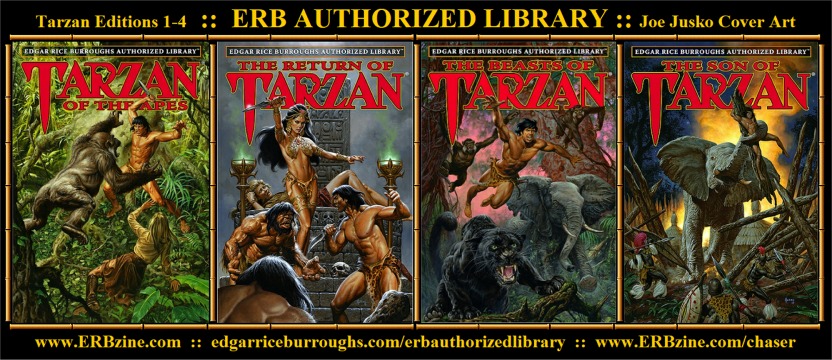
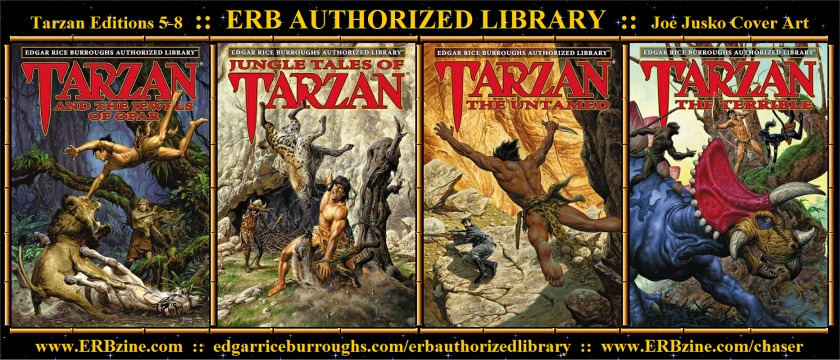
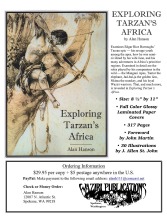 .
.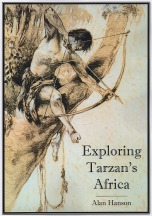 .
.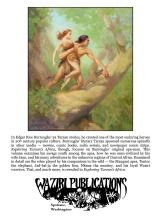
![]()
![]()
![]()
![]()

![]()